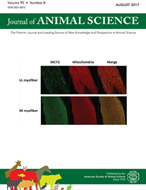-
Views
-
Cite
Cite
M. S. Davis, T. L. Mader, S. M. Holt, A. M. Parkhurst, Strategies to reduce feedlot cattle heat stress: Effects on tympanic temperature,,, Journal of Animal Science, Volume 81, Issue 3, March 2003, Pages 649–661, https://doi.org/10.2527/2003.813649x
Close - Share Icon Share
Abstract
Three experiments were conducted to evaluate the effect of different management strategies on body temperature of feedlot steers finished in the summer months. In Exp. 1, 24 crossbred steers were chosen to assess the effect of altered feed intake and feeding time on tympanic temperature (TT) response. Managed feeding (MF) treatments were applied for 22 d only and provided 1) ad libitum access to feed at 0800 (ADLIB), 2) feed at 1600 with amount adjusted so that no feed was available at 0800 (BKMGT), 3) feed at 1600 at 85% of predicted ad libitum levels (LIMFD). During heat stress conditions on d 20 to 22 of MF, LIMFD and BKMGT had lower (P < 0.05) TT than ADLIB from 2100 through 2400. A carryover effect of limit-feeding was evident during a severe heat episode (d 36 to 38) with LIMFD steers having lower (P < 0.05) TT than ADLIB. In Exp. 2, TT were obtained from 24 crossbred steers assigned to three treatments, consisting of no water application (CON), water applied to feedlot mound surfaces from 1000 to 1200 (AM) or 1400 to 1600 (PM). From 2200 to 0900 and 1200 to 1400, steers assigned to morning sprinkling treatment had lower (P < 0.05) TT than steers assigned to afternoon sprinkling treatment. In Exp. 3, 24 steers were utilized in a 2 × 2 factorial arrangement of treatments with factors of feeding time [0800 (AMF) and 1400 (PMF)] and sprinkling (WET and DRY). Tympanic temperatures were monitored under hot environmental conditions on d 30 to 32 and 61 to 62. A feeding time × sprinkling interaction (P < 0.001) was evident on d 30 to 32, although AMF/DRY steers had the highest (P < 0.05) TT. On d 61 to 62, TT of PMF steers was higher (P < 0.05) than AMF between 1500 to 1800. Use of sprinklers can effectively reduce TT of feedlot cattle, whereas shifting to an afternoon vs morning feeding time was most beneficial when bunks were empty several hours prior to feeding.





